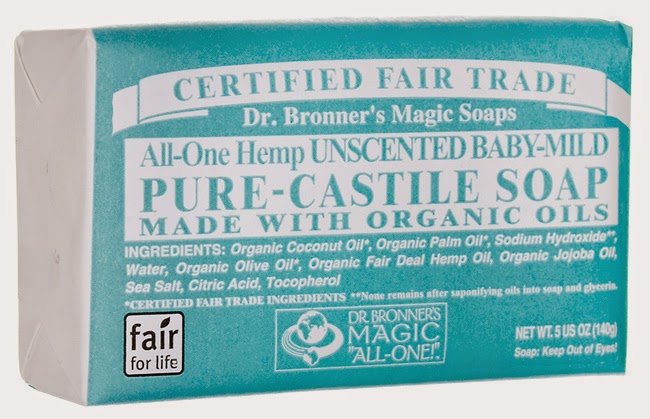I’ve seen many
variation of homemade laundry soap. I
never found one that worked well for me.
Plus, they are usually hard to make, make me choke, or end up
slimy! Here is my variation of a cost
effective, all natural laundry butter! This
recipe was adapted from the recipe from ibelieveicanfry.com. It called for Fels Naphtha soap. It gives me a headache, and the ingredients
are if-y, so I am replacing it with Castile bar soap.
Homemade Laundry
Butter
Ingredients:
1 bar (5 oz) Castile
Bar Soap
1 cup 20 Mule Team
Borax Powder
1 cup Arm & Hammer
WASHING Soda (NOT Baking Soda)
The original recipe
calls for using 2 wide-mouth quart mason jars or a single wide-mouth
half-gallon mason jar.
-First, cut the bar soap
into small cubes. Place into the mason jar (if using two jars, place half of
the soap in each jar).
-Add the 3 cups of
boiling water to the jar (1 1/2 cups per jar if using two jars). Let stand
about 6-8 hours or overnight. The soap will melt and re-gel into a thick
mixture.
-The next day (if you
can't get to it for a few days, that's totally fine), use a butter knife to cut
cross hatches into the gelled soap, loosening it from the bottom of the jar.
-Combine the borax and
washing soda, then add to the jar (if using two jars, combine 1/2 cup of borax
and 1/2 cup of washing soda and add to each jar).
-Add boiling water to
the jar, enough to come to the shoulder of the jar. For the half-gallon jar,
this is about 2 cups (so add 1 cup to each jar if using two quart jars). The
shoulder of the jar is the line where the jar just begins to slope up towards
the mouth of the jar.
-Using a
stick/immersion blender, whip the mixture until it becomes light and creamy
(about 30-45 seconds or so). It will resemble mayonnaise and thicken into an
emulsion.
-Allow the mixture to cool a few minutes (at least 20) and add the essential oils. Then mix with the mixer again.
The mixture will
thicken into a more solid, Crisco-like consistency after a few days - this is
totally normal! It's also normal for the mixture to turn more yellow as it
thickens if you use the Fels soap. The Castile soap stays a white color.
Use 1 Tbsp (1/2 oz)
per large load of laundry - this mixture will work in any type of machine
(front-load, top-load, high-efficiency).
NOTE: Do NOT add the laundry
butter to the detergent dispenser/compartment of your washer; it will get stuck
in there. Simply add the clothes to the washer, plop a dollop of laundry butter
on top of the clothes, just under where the water comes out, then turn on the
washer.
NOTE: This laundry mix
will NOT create a ton of suds or bubbles, but your clothes WILL get clean. Do
NOT add baking soda or products like OxyClean to the mixture.
UPDATE: I just wanted to add this. In my batch, I put in 10 drops each of Peppermint, Lavender, Lemon, and Tangerine EO's (get yours here). It smelled so good and the sent got stronger as it sat. The other cool thing, besides cleaning my laundry so well, was how it cleaned my washer! I was going to do a load of sheets and noticed my washer was smelling bad. I have an HE washer, and when I use laundry soap like Tide, it gunks up the washer making it smell horrible. Then you have to wash it with that powder stuff made to wash your washer...which seem kind of ironic and redundant. Anyway, I decided I was going to wash the washer after my load of sheets. I'm happy to report my washer was clean and smelled fresh when the load was done! BOOM!!
For more info on how to get essential oils into your home, email me at thenaturalcollective514@gmail.com
UPDATE: I just wanted to add this. In my batch, I put in 10 drops each of Peppermint, Lavender, Lemon, and Tangerine EO's (get yours here). It smelled so good and the sent got stronger as it sat. The other cool thing, besides cleaning my laundry so well, was how it cleaned my washer! I was going to do a load of sheets and noticed my washer was smelling bad. I have an HE washer, and when I use laundry soap like Tide, it gunks up the washer making it smell horrible. Then you have to wash it with that powder stuff made to wash your washer...which seem kind of ironic and redundant. Anyway, I decided I was going to wash the washer after my load of sheets. I'm happy to report my washer was clean and smelled fresh when the load was done! BOOM!!
For more info on how to get essential oils into your home, email me at thenaturalcollective514@gmail.com
Please note: Products mentioned in this article have not been evaluated by the FDA. These products and information on this page are not intended to diagnose, treat, cure, or prevent any disease. This website is not a substitute for professional care. If you have or suspect you may have a medical, psychological, or psychiatric problem, or a disability that requires medical attention, then you should consult your licensed medical doctor or appropriate health care provider. Always consult your medical doctor regarding your medical care. Never disregard professional medical advice or delay in seeking it because of something you have read on this website.





















